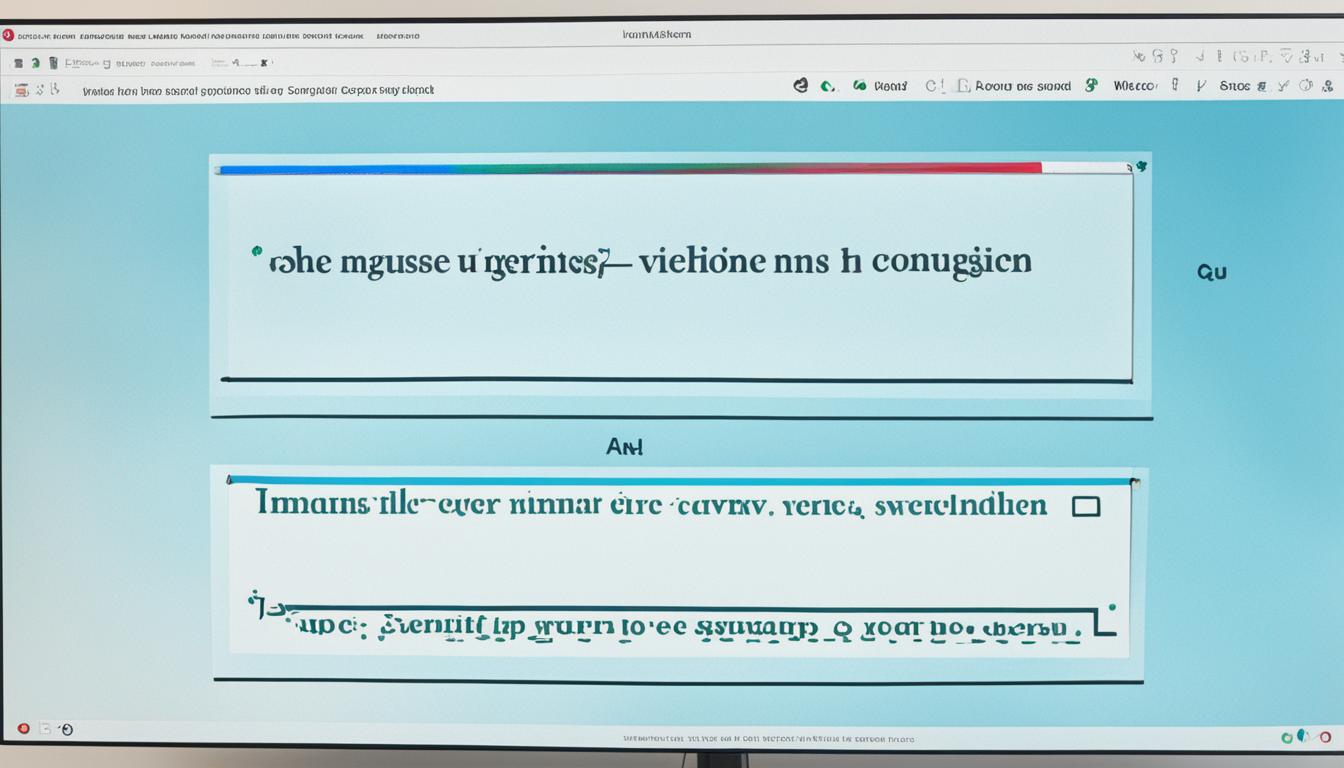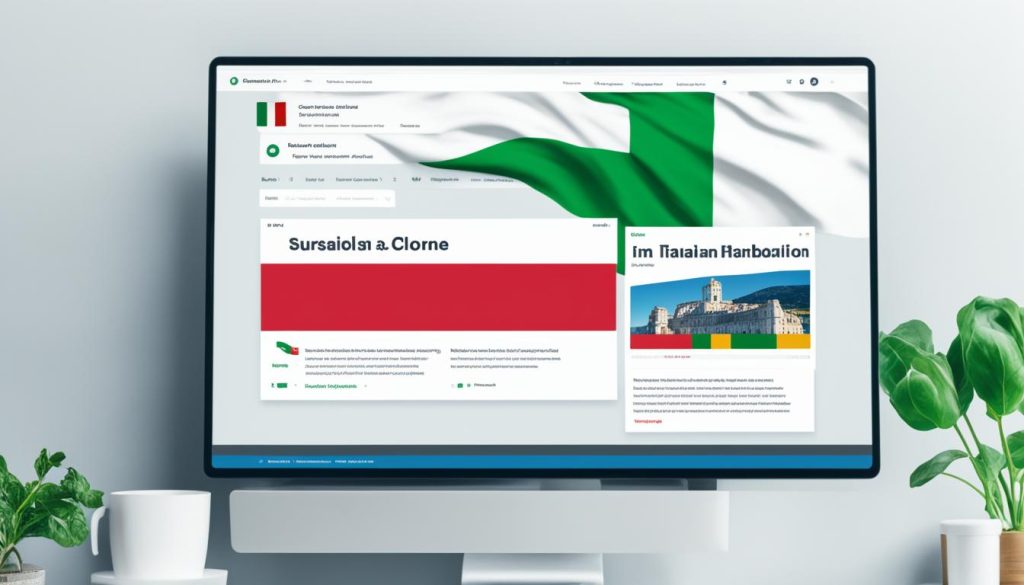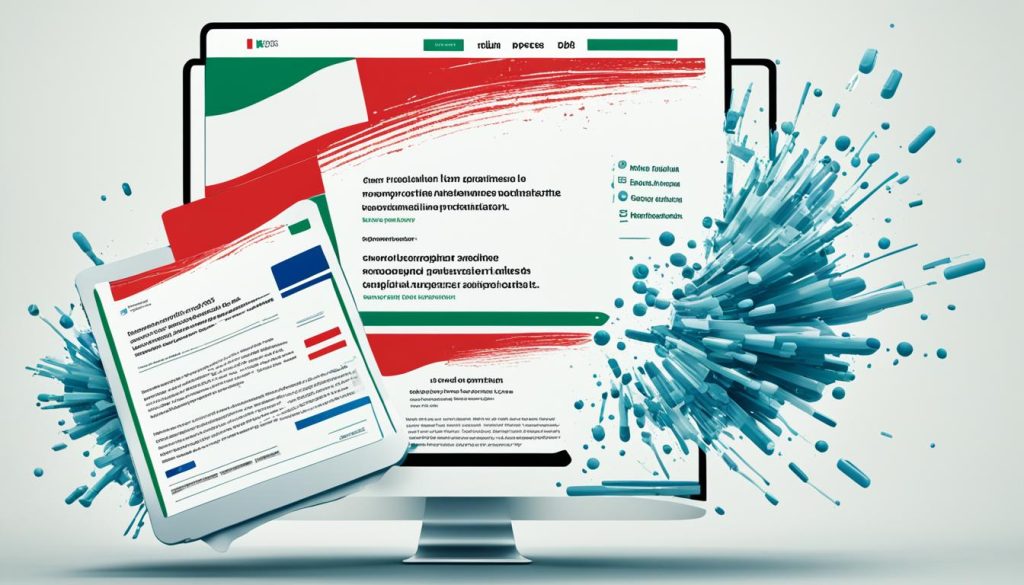Making a copy of your website for Italian readers is about keeping its core but making it fit for them. This step is key to good website localisation and growing your web presence in multiple languages. If you’re looking to reach the Italian market or better connect with Italian speakers, translating your content is essential. Using modern translation technology makes this easier, ensuring your message is both correct and culturally fitting.
Key Takeaways
- Website localisation is essential for connecting with a multilingual web presence.
- Italian market expansion is facilitated by effective content translation.
- Cloning your website ensures the original content is preserved and adapted accurately.
- Advanced translation tools enhance accuracy and streamline the process.
- Focus on cultural relevance to resonate with Italian-speaking customers.
Why You Should Clone Your Website for Italian Translation
Expanding your business into new areas is crucial for going international. One smart move is to clone your site and translate it for Italian speakers. This strategy opens up your business to a wider, global audience using a multilingual site.
A good translation does more than change words; it adapts to cultural nuances. It ensures your website not only talks the talk but walks the walk of your Italian market. Such careful adaptation increases trust and interaction by making content relatable to Italians everywhere.
Having a website in multiple languages has many benefits. It talks to more people, breaking down language barriers. It also builds trust with Italian users, showing you value their needs. This strategy fits perfectly with plans for growing your business globally, making you more competitive.
Offering a localised experience shows you respect your audience’s culture. This understanding is key to international business. It helps your brand stand out in the Italian market and connect deeply with Italian-speaking customers.
Benefits of a Multilingual Website
Having a website in multiple languages can boost your business. It lets you reach more people worldwide. Here are the top benefits of making your website multilingual.
Expand Your Reach
Being multilingual lets you connect with more people. By offering your content in various languages, you can enter new markets. It helps you speak to people in places where English isn’t the main language, helping your business grow.
Improve Your SEO
SEO also gets better with a multilingual website. By using local keywords in different languages, you’re more visible online. This means your website shows up in more searches around the world. Search engines like Google also prefer websites that work well in many languages.
Increase Customer Base
A multilingual site means you can reach non-English speakers. This opens the door to more customers. When people see your content in their language, they trust your business more.
This trust leads to better engagement and more sales over time. Everyone feels included, which is key for loyalty and long-term success.
Steps to Clone Your Website for Italian Translation
Cloning your website for Italian involves several key steps for accuracy and relevance. It requires careful planning and the right tools. A successful language switch is the goal.
Preparing Your Content
Start by checking your content for translation. Adapt it to fit Italy’s culture and laws. Make sure texts, images, and videos are right for Italian viewers.
Choosing the Right Tools
Choosing the right translation software is key. It should keep your website working well. Consider using DeepL, TranslatePress, or Crowdin for efficient and accurate translations.
Implementing the Translation
Now, implement the Italian translations. Make sure they stay true to the original content’s meaning. With the correct context, your website will connect well with Italian speakers.
Using WordPress to Create a Multilingual Website
Creating a website with WordPress in many languages can boost your global impact. You’ll reach more people and improve user experience by offering your content in several languages. WordPress makes it easy to do this while keeping your site easy to use in any language.
Translating WordPress Interface
Making your WordPress site support multiple languages begins with the backend. You’ll adjust the interface to let users manage content in their chosen language. With the help of plugins, this adjustment is smooth. It makes managing the site easier for those who don’t speak English, inviting more people to work with you.
Translating WordPress Theme and Plugins
It’s also key to translate your site’s theme and plugins. This ensures every part of your site looks and works right in any language. Themes and plugins that support localisation simplify this process. This keeps your site’s looks and functionality the same for everyone, no matter what language they choose.
Best Translation Tools for Cloning Your Website
It’s vital to pick the right translation tools for efficient website cloning. We’ll look at top translation tools. They ensure your multi-language site has quality translations and content syncing.
DeepL Translator: An Overview
DeepL is a top translation service known for high-quality results. It’s popular because it captures subtle meanings and provides precise translations. DeepL is perfect for those needing detailed and reliable translations.
TranslatePress Plugin Benefits
TranslatePress is a WordPress plugin that easily integrates with your site. It offers live translations and is SEO-friendly, ideal for reaching more people in different languages. The plugin makes translating content direct and simple.
Crowdin: Synchronisation and Quality Assurance
Crowdin is great for syncing content and ensuring translation quality. It automates keeping your web content consistent across languages. Crowdin’s strong quality checks ensure translations stay accurate, making it key for running multi-language websites.
Integrating TranslatePress for Italian Translations
Integrating TranslatePress for Italian translations makes the whole translation process easier for websites. It comes with user-friendly tools and a straightforward translation interface. By using TranslatePress, users can work on translations directly in WordPress. The live preview editor is a key benefit, letting you see edits in real-time. This is important for making sure translations are accurate and fit the context well.
TranslatePress offers a big benefit with its SEO compatibility. It helps keep your multilingual site SEO-friendly, so your pages rank well on search engines. For businesses wanting to grow in the Italian market, this is incredibly valuable. It helps increase visibility and reach more people.
The plugin is great for different types of translation workflows too. Whether you prefer manual translations or machine translation APIs, TranslatePress can handle it. It suits all sorts of translation needs, from small operations to big companies. Plus, it’s got easy-to-use management features that simplify translations.
On the whole, using TranslatePress for your site’s translations is smart and effective. Its easy interface and SEO-friendly aspects make it a great choice for translating websites, especially for the Italian audience. It simplifies the translation process on the WordPress platform.
Optimising Translated Content for SEO
When you translate a website, effective SEO localisation helps it reach the right people and score higher on search engines. It starts with translating metadata and using special URLs for different languages.
Translating Metadata
Translating titles, descriptions, and keywords is crucial. It lets search engines know your content is relevant in another language. If you use keywords that your local audience searches for, you can draw more people to your site. This boosts your site’s performance.
Using Dedicated URLs
Having a unique URL for each language version of your website is important. It tells search engines what language your page is in, which helps with indexing and ranking in local searches. For instance, a URL ending in “/it/” shows the content is for Italian speakers. This improves your site’s visibility and makes it easier for users.
How to Maintain Quality in Italian Translations
Ensuring top-notch Italian translations goes beyond just knowing the language. It requires deep linguistic skills and an understanding of culture. This mix makes sure the translation feels real to Italian readers.
Translation tools can provide a starting point with basic drafts. Yet, real people must check and edit these carefully to ensure precision. Professional translators fine-tune these drafts to meet what Italian audiences expect.
To keep translations excellent, quality checks are key. These steps help:
- Conducting thorough checks for translation accuracy and consistency.
- Utilising glossaries to standardise terminology usage.
- Referencing style guides tailored to the Italian language and culture.
Understanding cultural details is vital. Knowing Italy’s culture helps translators make content that doesn’t just translate words but also carries the message clearly. By following these approaches, translations can reach the highest quality and truly connect with Italian readers.
Localisation vs. Translation: Key Differences
Localisation and translation are crucial for businesses to reach wide audiences. Translation changes text from one language to another. Localisation, however, covers adapting content to fit cultural and local norms.
Understanding Localisation
Localisation is more than translating words. It includes changing content to connect with local cultures. Details like measuring units, date formats, and pictures are adjusted to match local preferences.
Applying Localisation Techniques
Localisation needs careful adaptation to meet local norms and laws. It involves translating texts and adjusting images, currencies, and legal notes. Success requires understanding local cultures, including names, user interfaces, and how people communicate.
Automating the Translation Process
Automating translation is crucial for businesses looking to improve efficiency and simplify localisation. With modern technologies, companies can translate content fast and with high accuracy. This leads to fewer manual tasks. Let’s look at how this automation helps and what tools are best.
Benefits of Automation
Automated translation brings many advantages:
- Increased Translation Efficiency: It speeds up translating large texts, leading to faster project finishes.
- Consistency Across Translations: Translation memories ensure phrases are consistently translated, keeping the style the same throughout.
- Cost-Effective Solutions: Automation reduces the need for a lot of human work, cutting costs.
Tools for Automation
There are plenty of tools to help automate translation. These tools aim to improve efficiency and make localisation smoother:
- Translation Memory: This saves past translations for reuse, boosting efficiency in future translations.
- Machine Translation Engines: Engines like Google’s Neural Machine Translation handle translations in real-time with impressive accuracy.
- Real-Time Content Preview Platforms: These tools show live previews of translations, ensuring the content looks right, which helps avoid extra revisions.
Using these tools greatly aids in automating translations. This makes the process quicker, more dependable, and easier to scale up. With these advanced solutions, companies can handle their multilingual content better. This opens doors to global markets.
Common Challenges in Website Translation
Translating a website for a global audience is tricky. The main issue is keeping the same tone, style, and accuracy across languages. Different languages have their own subtleties, making this hard.
Another challenge is updating content. Websites often change their information. This means translators must regularly update all language versions. They need to translate new stuff and update old content. This poses big multilingual website difficulties.
Then, there are technical issues. These come from trying to use different translation systems and tools together. They might not work well with each other. This can mess up how the website works and affect the user’s experience.
Idiomatic expressions and linguistic nuances pose yet another problem. Not all phrases or cultural references translate directly between languages. Skilled translators are vital. They find ways to make translations culturally appropriate. Creating effective language barrier solutions is key to overcoming these hurdles.
Examples of Successfully Translated Websites
Translating a website right needs careful planning and detailed localisation. By looking at translation case studies, we can learn a lot about what works. Let’s check out some examples that stand out:
- Coca-Cola: Coca-Cola’s work in localisation shows how a big brand keeps its feel across languages. They make sure their website speaks to everyone, considering cultural likes and language subtleties. This shows just how key it is to get translations that fit the context.
- Airbnb: Airbnb makes its site easy for everyone, thanks to its focus on speaking multiple languages. By tailoring content to match cultural norms, they increase user happiness and draw more people in.
- Alibaba: Alibaba going global highlights how vital good localisation is. With languages and options tailored for each country, Alibaba has grown worldwide.
These examples shed light on how powerful good translation and localisation can be for reaching more customers. By studying these cases, businesses can see how to do it right. Whether it’s Coca-Cola’s consistent image, Airbnb’s focus on the user, or Alibaba’s expansion achievements, these stories offer great lessons for a strong online impact.
Ensuring a Seamless User Experience
Making your website easy for Italian speakers is key to keeping them happy and engaged. It’s not just about translating words. Everything, like menus and buttons, must reflect Italian culture and how people there use the web.
It’s important that users find what they need easily. Everything should be clearly marked in Italian. This way, people won’t get lost or frustrated. Adding familiar terms helps users navigate more smoothly.
Also, paying attention to cultural details in design helps. Things like colours and images should suit Italian tastes. This makes users more comfortable. Our goal is to blend language and culture well. This keeps users coming back to your website.





